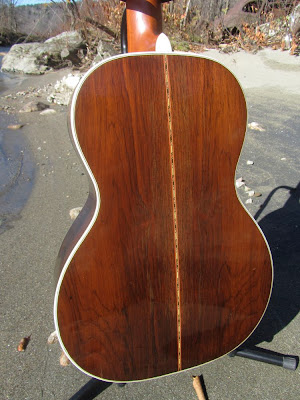c.1910 Larson-made Stahl "Parlor" Guitar
This pearl-trimmed, slightly-under 00-sized guitar is owned by a friend of mine and boy am I jealous!
While branded "Stahl" in the soundhole, this is a Stahl that was made by the Larson Brothers, those oh-so-famous Swedish fellas in Chicago who have in recent times started to get the renown they deserve.
So what does that mean as far as this guitar is concerned? High class, high quality, and wonderful sound -- rich, sustained, full, and precise whether flatpicking or fingerpicking.
This guitar sports its original finish which is in gleamingly-good condition. It's possible the top was either lightly French polished at some point to bring it back up to luster or it was simply buffed up because there is a small amount of pick wear at the treble side of the soundhole that has been blended into the finish.
Either way, it hardly matters. The condition of the instrument speaks for itself: extremely well-kept! It is also crack-free except for a couple under-1" hairline cracks with the grain on the back.
...and if you were wondering, this is a 13 3/4" wide body and the top is ladder-braced, though in typical Larson fashion the build is well-thought-out and very sturdy.
These were built in what we call "domed" fashion today, with the top and back built "under tension" over slightly curved braces. This means that compared to a typical ladder-braced Harmony, Regal or other mail-order guitar of the time, the top and back have a slight "dome" shape overall, and with the wood flexed in this manner it's much more stable than a flat piece of wood that can more easily bend or warp... and a more-stable top means better sustain, clearer tone, better volume, and so forth.
The headstock and fretboard are bound in the same white celluloid that the rest of the instrument has all over it. The headstock has a nice dark-stained rosewood veneer on it and check out the slotted cuts: they've been squared-off for a super-elegant look. That's an inlaid pearl "snowflake" at the top of the headstock.
Original frets, dressed nicely, in an ebony fretboard. This board hasn't been "ebonized" so the natural grain is allowed to show through which looks simply beautiful. The pearl-inlay workmanship is also top-notch for the time and very clean.
Nice "Chicago" style bridge with inlaid "wings." The pins appear to all be original ivory types with pearl dots inlaid.
Lovely soundhole rosette and pearl top edging! Notice the red piping that really pops the pearl out and also the nice soundhole binding -- a very "Chicago" (vs. Nazareth) addition. The appointments on this guitar are similar to early Martin style-45 trim.
Gorgeous stuff...
The Brazilian rosewood, as typical for a Larson-made instrument, is fantastic and beautiful. Many firms at the time sought out very straight-grain rosewood, but the Larsons seemed to have really enjoyed stuff with good figure and an interesting mix of colors.
The neck looks like nice Spanish cedar as opposed to "true" South American mahogany to me, but I might be wrong. At any rate, they're in the same family and have much the same strength characteristics. Spanish cedar is the stuff used in classical guitars to this day and was found on most nice guitars (read: Washburns, Martins, etc.) up until the 1920s.
I love the multicolored, inlaid backstrip. The heel is also perfectly fit to this guitar.
Wonderful rosewood used for the sides, too!
The rosewood is so pretty on this side!
Nice Waverly tuners.
Ivory end-strip with pearl-inlaid ebony endpin. Classy!
Here's the "Wm. C. Stahl" mark on the inside. The penciled-in bit at the top of the photo reads "J.B. Sutton" -- though, except for a possible Tennessee general store connection, the lead seems to be dead.



















Comments
I bought this beauty from EZ about a year ago. It's become my favorite guitar.
A friend of mine stopped at your shop over the weekend and said it was wonderful. I'll make a trip up sometime.
Cheers,
Bill